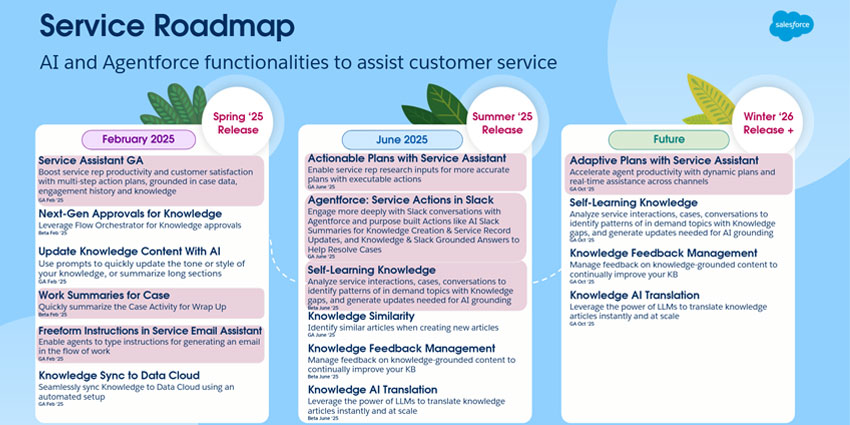The Salesforce Service Assistant is now generally available on Service Cloud.
There, the assistant develops step-by-step plans to help live agents handle queries, considering intent, case history, and additional customer context.
The solution entered a pilot in October 2024 under the name “Salesforce Service Planner”. Just four months later, it’s ready to go live.
However, Salesforce recommends that users ground its Service Assistant – through Data Cloud and the contact center knowledge base – to ensure accuracy.
Doing so will give the assistant knowledge of the company’s processes and the customer’s history – across service, sales, marketing, and beyond.
Alongside agent guidance, the Service Assistant provides two other notable features.
The first enables agents to create conversation summaries with “just a click” after using the solution to complete a case.
The second allows agents to request that the assistant auto-crafts a new knowledge article when its guidance proved insufficient, based on how they resolved the query.
Thanks to this second feature, the Service Assistant may get better with time, aiding agent proficiency, customer satisfaction, and – ultimately – average handling time (AHT).
However, despite this capability, Salesforce has pledged to advance the solution further.
Indeed, during a recent webinar, Kevin Qi, Associate Product Manager at Salesforce, teased what will come in June.
Pointing to Service Cloud’s Summer ‘25 release wave, Qi said:
The next phase of Service Assistant involves actionable plans. So, not only will it help guide the service rep, but it’ll also take actions to automate various steps, so it can look up orders, check eligibilities, and more to help speed up the efficiency of tackling that case.
Beyond the summer, Salesforce plans to have the Assistant blend modalities, guiding customer conversations across channels to further streamline the interaction.
“The Service Assistant will become even more adaptive, support more channels, including messaging and voice, being able to adapt to changes in case context,” concluded Qi.
The Latest AI Solutions on Service Cloud
Alongside the Service Assistant, Salesforce has released several other AI and Agentforce capabilities, embedded across Service Cloud.
Qi picked out the “Freeform Instructions in Service Email Assistant” feature for special reference.
“If the agent doesn’t have a template already made for a particular instance, they can type – in natural language – the sort of email they’d want to generate and have Agentforce create that email in the flow of work,” he said.
That capability may prove highly beneficial in helping agents piece their thoughts together when resolving a tricky case. After all, they can note some key points – in natural language – and the feature will create a coherent customer response.
Alongside this comes a solution to quickly summarize case activity for wrap-up in beta.
Yet, most new features focus on improving the knowledge that feeds into AI solutions, like the Service Assistant.
For starters, there’s a flow orchestrator in beta that helps contact center leaders build a process for approving new knowledge articles and updates.
Additionally, there’s an “Update Knowledge Content with AI” feature. This ingests prompts and – as it says on the tin – updates the tone, style, and length of particular knowledge articles.
Last comes the “Knowledge Sync to Data Cloud” tool that pulls contact center knowledge into the Salesforce customer data platform (CDP). Not only does this democratize service insights, but it also supports contact centers in grounding the Service Assistant and other AI agents.
Both of these final knowledge capabilities are now generally available.
What’s Coming in the Summer ’25 Release?
Aside from the Service Assistant updates, perhaps the most exciting feature touted in June’s Summer ’25 Service Cloud release is “Agentforce: Service Actions in Slack”.
Salesforce already enables swarming in Slack, so contact center agents can connect with external employees to solve complex customer cases.
However, starting in June, Salesforce will take that guidance from Slack and have it appear in the case summary and record on Service Cloud.
Additionally, the feature will offer to transform the guidance into a knowledge article, so future agents don’t need to seek external help when solving similar queries.
That new knowledge capability is one of several that will be available in June. Of these, Qi spotlighted the “Self-Learning Knowledge” feature, which will land in beta testing.
“Contact centers must keep their knowledge base up-to-date and consisting of the latest information,” he said. “With this feature going beta in the summer, it uses AI to automatically flag opportunities to enhance content, sharing suggestions.”
There are three other knowledge management features coming to Service Cloud in June.
Its “Knowledge Similarity” capability is perhaps most innovative. It isolates similar articles when building new knowledge content. As such, contact centers can update those instead of creating similar pieces with confusing overlaps. The feature will immediately become generally available.
The other two features – “Knowledge Feedback Management” and “Knowledge AI Translation” – will arrive in beta.
Don’t Forget About Agentforce…
While the announcement above covers the preconfigured AI and Agentforce capabilities coming to Service Cloud, brands can build their own leveraging Agentforce.
The platform contains an AI agent builder that service teams – and various other departments – can utilize to automate enterprise flows.
In doing so, they may autonomously handle customer conversations, automate proactive outreach, mechanize quality assurance (QA) processes, and much more.
In addition, with Agentforce and Data Cloud, brands can connect cross-platform flows to automate more of the enterprise.
Since its launch, Salesforce has already scooped 1,000 Agentforce customers.
Now, it’s set to release Agentforce 2.0, as teased in December 2024.







